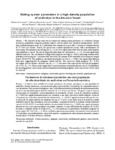Por favor, use este identificador para citar o enlazar este ítem:
http://www.alice.cnptia.embrapa.br/alice/handle/doc/966022Registro completo de metadatos
| Campo DC | Valor | Lengua/Idioma |
|---|---|---|
| dc.contributor.author | CAMPOS, T. de | pt_BR |
| dc.contributor.author | CUNHA, M. O. da | pt_BR |
| dc.contributor.author | SOUSA, A. C. B. de | pt_BR |
| dc.contributor.author | TEIXEIRA, R. B. | pt_BR |
| dc.contributor.author | RAPOSO, A. | pt_BR |
| dc.contributor.author | SEBBENN, A. M. | pt_BR |
| dc.contributor.author | WADT, L. H. de O. | pt_BR |
| dc.date.accessioned | 2013-09-10T11:11:11Z | pt_BR |
| dc.date.available | 2013-09-10T11:11:11Z | pt_BR |
| dc.date.created | 2013-09-10 | pt_BR |
| dc.date.issued | 2013 | pt_BR |
| dc.identifier.citation | Pesquisa Agropecuária Brasileira, Brasília, DF, v. 48, n. 5, p. 504-509, maio 2013. | pt_BR |
| dc.identifier.uri | http://www.alice.cnptia.embrapa.br/alice/handle/doc/966022 | pt_BR |
| dc.description | The objective of this work was to estimate the mating system parameters of a andiroba (Carapa guianensis) population using microsatellite markers and the mixed and correlated mating models. These results suggest that, in order to maintain a minimum effective size of 150 individuals for breeding, genetic conservation, and environmental reforestation programs, seeds from at least 56 trees must be collected. | pt_BR |
| dc.language.iso | eng | eng |
| dc.rights | openAccess | eng |
| dc.subject | Marcador microssatélite | pt_BR |
| dc.subject | Allogamy | pt_BR |
| dc.subject | Cruce | pt_BR |
| dc.subject | Fitomejoramiento | pt_BR |
| dc.subject | Madera tropical | pt_BR |
| dc.subject | Marcadores genéticos | pt_BR |
| dc.subject | Repeticiones de microsatélite | pt_BR |
| dc.title | Mating system parameters in a high density population of andirobas in the Amazon forest. | pt_BR |
| dc.type | Artigo de periódico | pt_BR |
| dc.date.updated | 2017-06-28T11:11:11Z | pt_BR |
| dc.subject.thesagro | Melhoramento genético vegetal | pt_BR |
| dc.subject.thesagro | Essência florestal | pt_BR |
| dc.subject.thesagro | Andiroba | pt_BR |
| dc.subject.thesagro | Carapa guianensis | pt_BR |
| dc.subject.thesagro | Reprodução vegetal | pt_BR |
| dc.subject.thesagro | Cruzamento | pt_BR |
| dc.subject.thesagro | Alogamia | pt_BR |
| dc.subject.thesagro | Marcador genético | pt_BR |
| dc.subject.nalthesaurus | Plant breeding | pt_BR |
| dc.subject.nalthesaurus | Tropical wood | pt_BR |
| dc.subject.nalthesaurus | Crossing | pt_BR |
| dc.subject.nalthesaurus | Genetic markers | pt_BR |
| dc.subject.nalthesaurus | Microsatellite repeats | pt_BR |
| riaa.ainfo.id | 966022 | pt_BR |
| riaa.ainfo.lastupdate | 2017-06-28 | pt_BR |
| dc.contributor.institution | TATIANA DE CAMPOS, CPAF-AC | pt_BR |
| dc.contributor.institution | MARCIA OLIVEIRA DA CUNHA, UNIÃO EDUCACIONAL DO NORTE | eng |
| dc.contributor.institution | ADNA CRISTINA BARBOSA DE SOUSA, UNIVERSIDADE DO ESTADO DA BAHIA | eng |
| dc.contributor.institution | RENATA BELTRAO TEIXEIRA, CPAF-AC | eng |
| dc.contributor.institution | ANDREA RAPOSO, CPAF-AC | eng |
| dc.contributor.institution | ALEXANDRE MAGNO SEBBENN, INSTITUTO FLORESTAL DE SÃO PAULO | eng |
| dc.contributor.institution | LUCIA HELENA DE OLIVEIRA WADT, CPAF-AC. | eng |
| Aparece en las colecciones: | Artigo em periódico indexado (CPAF-AC)  | |
Ficheros en este ítem:
| Fichero | Descripción | Tamaño | Formato | |
|---|---|---|---|---|
| 24682.pdf | 423,57 kB | Adobe PDF |  Visualizar/Abrir |









